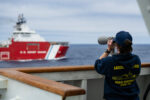At the DSEI 2025 exhibition in London, Danish defense firm Copenhagen Global unveiled its new Orca Unmanned Surface Vehicle (USV), a stealthy platform tailored for covert maritime intelligence, surveillance, and reconnaissance (ISR) operations. Designed with a low profile and modular payload architecture, the Orca aims to provide NATO-aligned navies with a cost-effective and persistent sensor node in contested littoral zones.
Design Philosophy and Stealth Features
The Orca USV is engineered around a minimalist radar cross-section (RCS) footprint to enhance survivability during clandestine operations. With a catamaran hull form and ultra-low freeboard—reportedly less than 50 cm—the vessel presents a minimal silhouette above water. This design reduces visual detection while also minimizing radar returns.
Copenhagen Global emphasized that the Orca is optimized for passive observation rather than active engagement. The platform lacks any onboard weaponry in its base configuration but can be outfitted with modular payloads depending on mission needs. The stealth-centric design includes:
- Composite materials to reduce infrared signature
- Flush-mounted antennas and sensors to avoid protrusions
- Electric propulsion system for reduced acoustic signature
Payloads and Mission Flexibility
The Orca’s mission bay supports modular payload integration via standardized interfaces. At DSEI 2025, the displayed configuration included an electro-optical/infrared (EO/IR) turret mounted on a retractable mast and passive electronic surveillance measures (ESM) sensors. These allow the platform to silently monitor RF emissions from ships or coastal installations.
Other potential payloads include:
- Synthetic Aperture Radar (SAR) modules for all-weather imaging
- AIS spoofing detection systems
- Underwater acoustic sensors or hydrophones for submarine tracking in chokepoints
The open-architecture design allows rapid reconfiguration between ISR, environmental monitoring, or even mine countermeasure (MCM) roles. However, Copenhagen Global clarified that the current focus is strictly on ISR applications.
Autonomy and Communications Architecture
The Orca is semi-autonomous with supervised remote control via satellite or line-of-sight datalinks. It uses encrypted communications protocols compliant with NATO STANAG standards. The autonomy stack includes waypoint navigation, obstacle avoidance using LiDAR and EO sensors, and return-to-base logic under comms loss conditions.
Copenhagen Global has partnered with Danish software firm MyDefence to integrate secure mesh networking capabilities into the platform’s C2 suite. This enables distributed operations among multiple Orcas or integration into larger naval task groups as unmanned scouts.
Operational Use Cases and Strategic Context
The Orca is designed primarily for grey-zone maritime operations—below the threshold of armed conflict but requiring persistent situational awareness. Potential use cases include:
- Monitoring disputed EEZ boundaries without risking manned platforms
- Shadowing foreign naval activity near critical infrastructure or sea lanes
- Providing overwatch during amphibious landings or special forces insertions
This aligns with broader NATO interest in distributed maritime ISR capabilities amid increasing Russian naval activity in the Baltic Sea and Arctic regions. Denmark’s geographic position makes it a logical proponent of such technologies.
Status, Testing Timeline, and Market Outlook
Copenhagen Global indicated that sea trials of the Orca prototype began in Q3 2024 off Denmark’s eastern coast near Bornholm Island. Initial testing focused on endurance—claimed to be over 72 hours—and sensor performance under varying sea states.
The company aims to reach Technology Readiness Level (TRL) 7 by mid-2026 following extended trials with Danish Navy support elements. A limited production run could begin as early as late-2026 if procurement interest materializes from allied navies or EU-funded border security programs such as PESCO MARISA.
The Orca enters a growing field of small-to-medium class USVs including Elbit’s Seagull, L3Harris’ Iver family (for MCM), and Turkey’s ULAQ platform—but differentiates itself through its extreme low-profile design tailored specifically for covert ISR rather than multi-role combat functions.
Conclusion: A Niche Capability Filling Emerging Gaps
The Copenhagen Orca represents a focused approach to unmanned maritime surveillance—eschewing weaponization in favor of stealthy persistence in contested waters. As Western navies seek cost-effective ways to extend their sensor reach without escalating tensions or risking personnel loss, platforms like the Orca could play an increasingly vital role in layered maritime domain awareness architectures.
If successfully integrated into broader C4ISR networks—and proven reliable across harsh littoral environments—the Orca may find traction not only within Scandinavian defense circles but also among NATO partners seeking scalable unmanned solutions below traditional warfighting thresholds.









